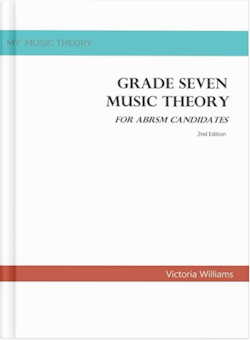ABRSM Grade 7 Music Theory Free Lessons
On this page you can find the syllabus information, and links to the free and paid ABRSM Grade 7 Music Theory lessons available on this site.
You will find a large number of free lessons on this website, or get the full ABRSM Grade 7 Music Theory course in your preferred format:
Scales, Keys and Chords
- Identifying the Home Key
- Chord vii°7 (Diminished 7th)
- Secondary 7ths
- The Neapolitan 6th
- Direct Modulation
- The Whole Tone Scale
Decoration
- Using Decoration Notes
- Suspensions
- Simultaneous Decoration
- Decoration Mistakes to Avoid
- Analysing Harmony with Decoration Notes
Chord Progressions
Figured Bass
- Figured Bass Review
- Figured Bass (ABRSM Grade 7)
- Added 7th Chords (Figured Bass)
- Suspensions (Figured Bass)
- Figure 4 (Figured Bass)
- Added 9th Chords
- Q1 | Figuring a Bass Line (ABRSM Grade 7)
- Q1 | Problem Areas (ABRSM Grade 7)
- Q1 | Getting Top Marks (ABRSM Grade 7)
Harmony Reconstruction
- Q2 | Chorale Reconstruction (ABRSM Grade 7)
- Lutheran Chorales
- Q2 | Method (Chorales)
- Q2 | Keyboard Reconstruction
- Q2 | Keyboard Openings
- Q2 | Keyboard Voice Leading
- Q2 | Keyboard Decoration
- Q2 | Keyboard Accompaniment Styles
Composition
General Knowledge
- Enharmonic Transposition
- Crossing Parts
- Identifying Chords (ABRSM Grade 7)
- Instruments (ABRSM Grade 7)
- The Woodwind Section
Practice Test
ABRSM Grade 7 Music Theory Practice Test
ABRSM Syllabus (Grade 7)
As in preceding grades, with the following additions:
- The recognition of all diatonic secondary seventh chords and their inversions.
- The Neapolitan sixth and the diminished seventh chords.
- All figures commonly used by composers during the period c.1620–1790 to indicate harmonies above a bass part.
Questions will cover:
- The indication of chords and movement of the inner parts by figuring the bass in a passage in which both the melody and bass are given.
- Rewriting a given passage to include appropriate suspensions and notes of melodic decoration.
- Continuation of a given opening for solo instrument with keyboard accompaniment, which will be given in full throughout the passage, by completing the solo part, or, at the candidate’s choice, composition of a melody for a specified instrument (a choice will be provided) based on a given progression of chords or melodic figure.
- Questions on short extracts of music written for piano or in open score for voices or for any combination of instruments and/or voices, designed to test the candidate’s knowledge of the elements and notation of music, including the realisation of ornaments, the identification and notation of underlying harmonic structure, phrase structure, style, performance, and on the voices and instruments for which the works were written.
Read the ABRSM syllabus here.


